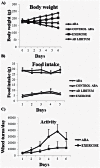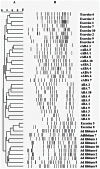Gut microbiota composition in male rat models under different nutritional status and physical activity and its association with serum leptin and ghrelin levels - PubMed (original) (raw)
Gut microbiota composition in male rat models under different nutritional status and physical activity and its association with serum leptin and ghrelin levels
María Isabel Queipo-Ortuño et al. PLoS One. 2013.
Abstract
Background: Several evidences indicate that gut microbiota is involved in the control of host energy metabolism.
Objective: To evaluate the differences in the composition of gut microbiota in rat models under different nutritional status and physical activity and to identify their associations with serum leptin and ghrelin levels.
Methods: In a case control study, forty male rats were randomly assigned to one of these four experimental groups: ABA group with food restriction and free access to exercise; control ABA group with food restriction and no access to exercise; exercise group with free access to exercise and feed ad libitum and ad libitum group without access to exercise and feed ad libitum. The fecal bacteria composition was investigated by PCR-denaturing gradient gel electrophoresis and real-time qPCR.
Results: In restricted eaters, we have found a significant increase in the number of Proteobacteria, Bacteroides, Clostridium, Enterococcus, Prevotella and M. smithii and a significant decrease in the quantities of Actinobacteria, Firmicutes, Bacteroidetes, B. coccoides-E. rectale group, Lactobacillus and Bifidobacterium with respect to unrestricted eaters. Moreover, a significant increase in the number of Lactobacillus, Bifidobacterium and B. coccoides-E. rectale group was observed in exercise group with respect to the rest of groups. We also found a significant positive correlation between the quantity of Bifidobacterium and Lactobacillus and serum leptin levels, and a significant and negative correlation among the number of Clostridium, Bacteroides and Prevotella and serum leptin levels in all experimental groups. Furthermore, serum ghrelin levels were negatively correlated with the quantity of Bifidobacterium, Lactobacillus and B. coccoides-Eubacterium rectale group and positively correlated with the number of Bacteroides and Prevotella.
Conclusions: Nutritional status and physical activity alter gut microbiota composition affecting the diversity and similarity. This study highlights the associations between gut microbiota and appetite-regulating hormones that may be important in terms of satiety and host metabolism.
Conflict of interest statement
Competing Interests: The authors have declared that no competing interests exist.
Figures
Figure 1. Representation of the relative daily body weight variation (A) and daily food intake (B) in the all study groups (N = 10 rats per group).
The figure (C) shows a 23 h registered activity in ABA and exercise groups.
Figure 2. Serum leptin (A) and grhelin (B) levels (C) at day 6 of study in all rat groups (N = 10 rats per group).
The Mann-Whitney U test was used to compare a rat group to each other. Different superscript letters are significantly different P<0.05 (Bonferroni Post-hoc test).
Figure 3. Dendrograms of electrophoretic band patterns obtained in the denaturing gel gradient electrophoresis experiment with universal primers in the fecal samples collected from ABA, control ABA (cABA), exercise and ad libitum rats.
A: Cluster analysis; B: DGGE profiles of fecal samples.
Similar articles
- Gut microbiota in children with type 1 diabetes differs from that in healthy children: a case-control study.
Murri M, Leiva I, Gomez-Zumaquero JM, Tinahones FJ, Cardona F, Soriguer F, Queipo-Ortuño MI. Murri M, et al. BMC Med. 2013 Feb 21;11:46. doi: 10.1186/1741-7015-11-46. BMC Med. 2013. PMID: 23433344 Free PMC article. - Gut microbiota profile in healthy Indonesians.
Rahayu ES, Utami T, Mariyatun M, Hasan PN, Kamil RZ, Setyawan RH, Pamungkaningtyas FH, Harahap IA, Wiryohanjoyo DV, Pramesi PC, Cahyanto MN, Sujaya IN, Juffrie M. Rahayu ES, et al. World J Gastroenterol. 2019 Mar 28;25(12):1478-1491. doi: 10.3748/wjg.v25.i12.1478. World J Gastroenterol. 2019. PMID: 30948911 Free PMC article. - Senior Thai fecal microbiota comparison between vegetarians and non-vegetarians using PCR-DGGE and real-time PCR.
Ruengsomwong S, Korenori Y, Sakamoto N, Wannissorn B, Nakayama J, Nitisinprasert S. Ruengsomwong S, et al. J Microbiol Biotechnol. 2014 Aug;24(8):1026-33. doi: 10.4014/jmb.1310.10043. J Microbiol Biotechnol. 2014. PMID: 24743571 - Human gut microbiota and bifidobacteria: from composition to functionality.
Turroni F, Ribbera A, Foroni E, van Sinderen D, Ventura M. Turroni F, et al. Antonie Van Leeuwenhoek. 2008 Jun;94(1):35-50. doi: 10.1007/s10482-008-9232-4. Epub 2008 Mar 13. Antonie Van Leeuwenhoek. 2008. PMID: 18338233 Review. - Current Aspects of the Role of Autoantibodies Directed Against Appetite-Regulating Hormones and the Gut Microbiome in Eating Disorders.
Smitka K, Prochazkova P, Roubalova R, Dvorak J, Papezova H, Hill M, Pokorny J, Kittnar O, Bilej M, Tlaskalova-Hogenova H. Smitka K, et al. Front Endocrinol (Lausanne). 2021 Apr 19;12:613983. doi: 10.3389/fendo.2021.613983. eCollection 2021. Front Endocrinol (Lausanne). 2021. PMID: 33953692 Free PMC article. Review.
Cited by
- Acacia Polyphenol Ameliorates Atopic Dermatitis in Trimellitic Anhydride-Induced Model Mice via Changes in the Gut Microbiota.
Ikarashi N, Fujitate N, Togashi T, Takayama N, Fukuda N, Kon R, Sakai H, Kamei J, Sugiyama K. Ikarashi N, et al. Foods. 2020 Jun 11;9(6):773. doi: 10.3390/foods9060773. Foods. 2020. PMID: 32545274 Free PMC article. - The Gut Microbiota Profile in Children with Prader-Willi Syndrome.
Peng Y, Tan Q, Afhami S, Deehan EC, Liang S, Gantz M, Triador L, Madsen KL, Walter J, Tun HM, Haqq AM. Peng Y, et al. Genes (Basel). 2020 Aug 7;11(8):904. doi: 10.3390/genes11080904. Genes (Basel). 2020. PMID: 32784572 Free PMC article. - Assessing the relationship between physical activity and the gut microbiome in a large, population-based sample of Wisconsin adults.
Holzhausen EA, Malecki KC, Sethi AK, Gangnon R, Cadmus-Bertram L, Deblois CL, Suen G, Safdar N, Peppard PE. Holzhausen EA, et al. PLoS One. 2022 Oct 26;17(10):e0276684. doi: 10.1371/journal.pone.0276684. eCollection 2022. PLoS One. 2022. PMID: 36288361 Free PMC article. - Drastic Effects on the Microbiome of a Young Rower Engaged in High-Endurance Exercise After a Month Usage of a Dietary Fiber Supplement.
Jaago M, Timmusk US, Timmusk T, Palm K. Jaago M, et al. Front Nutr. 2021 Apr 30;8:654008. doi: 10.3389/fnut.2021.654008. eCollection 2021. Front Nutr. 2021. PMID: 33996876 Free PMC article. - Fecal and Blood Microbial 16s rRNA Gene Alterations in Chinese Patients with Multiple System Atrophy and Its Subtypes.
Du J, Huang P, Qian Y, Yang X, Cui S, Lin Y, Gao C, Zhang P, He Y, Xiao Q, Chen S. Du J, et al. J Parkinsons Dis. 2019;9(4):711-721. doi: 10.3233/JPD-191612. J Parkinsons Dis. 2019. PMID: 31381527 Free PMC article.
References
- Yager J, Anderson AE (2005) Anorexia nervosa. N Engl J Med 353(14): 1481–1488. - PubMed
- Affenito SG, Dohm FA, Crawford PB, Daniels SR, Striegel-Moore RH (2002) Macronutrient intake in anorexia nervosa: The National Heart, Lung, and Blood Institute Growth and Health Study. J Pediatr 141(5): 701–705. - PubMed
- Payne AN, Chassard C, Banz Y, Lacroix C (2012) The composition and metabolic activity of child gut microbiota demonstrate differential adaptation to varied nutrient loads in an in vitro model of colonic fermentation. FEMS Microbiol Ecol 80(3): 608–623. - PubMed
- Kowalska I, Karczewska-Kupczewska M, Strączkowski M (2011) Adipocytokines, gut hormones and growth factors in anorexia nervosa. Clin Chim Acta 412(19–20): 1702–1711. - PubMed
- Hebebrand J, Muller TD, Holtkamp K, Herpertz-Dahlmann B (2007) The role of leptin in anorexia nervosa: clinical implications. Mol Psychiatry 12(1): 23–35. - PubMed
Publication types
MeSH terms
Substances
Grants and funding
This work was supported in part by a grant from CIBER (Centro de Investigación en Red) CB06/03/0018 of the "Instituto de Salud Carlos III (ISCIII)", the Instituto de Salud Carlos III CP07/0095 Madrid (Spain), the Servicio Andaluz de Salud (PI0696/2010) and Fondo de Investigacion Sanitaria (FIS) PI12/02355 from the Instituto de Salud Carlos III (ISCIII), Madrid (Spain). The post-doctoral grant “Sara Borrell” (CD11/0030) from the Spanish Ministry of Economy and Competitiveness (MM) and the Miguel Servet Fellow from the Instituto de Salud Carlos III/SERGAS (MP). The funders had no role in study design, data collection and analysis, decision to publish, or preparation of the manuscript.
LinkOut - more resources
Full Text Sources
Other Literature Sources


